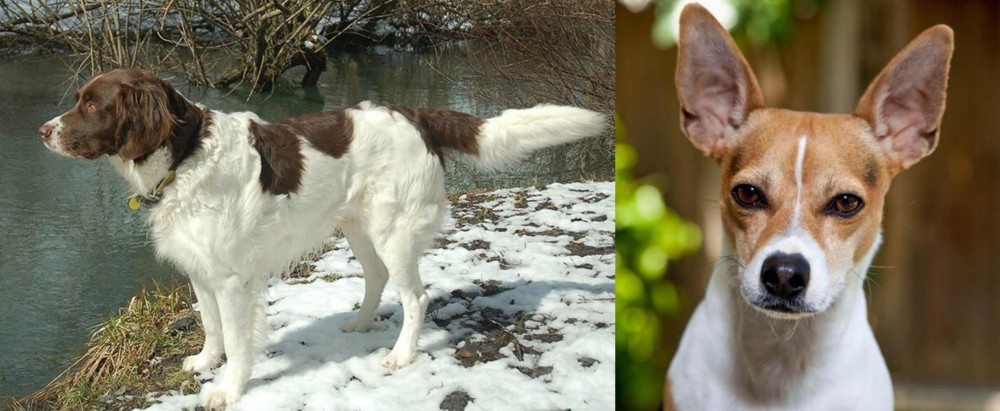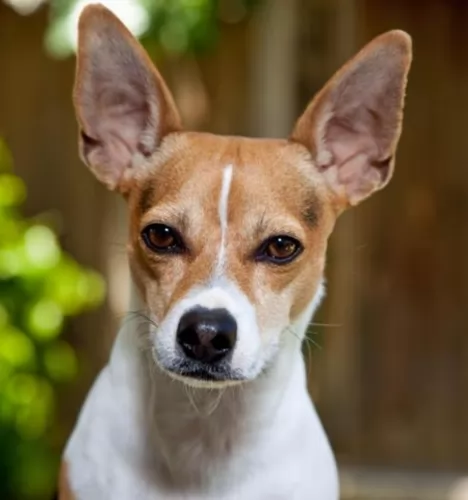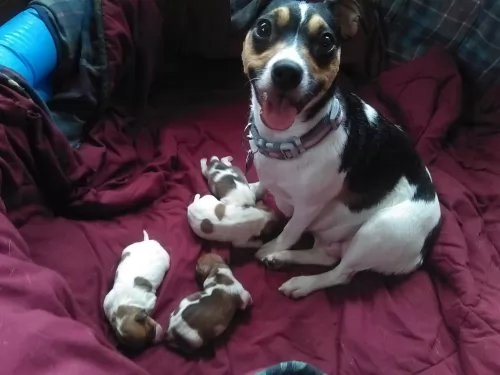 Petzlover
Petzlover Drentse Patrijshond is originated from Netherlands but Rat Terrier is originated from United States. Drentse Patrijshond may grow 27 cm / 11 inches higher than Rat Terrier. Drentse Patrijshond may weigh 26 kg / 58 pounds more than Rat Terrier. Drentse Patrijshond may live 3 years less than Rat Terrier. Both Drentse Patrijshond and Rat Terrier has same litter size. Drentse Patrijshond requires Moderate Maintenance. But Rat Terrier requires Low Maintenance
Drentse Patrijshond is originated from Netherlands but Rat Terrier is originated from United States. Drentse Patrijshond may grow 27 cm / 11 inches higher than Rat Terrier. Drentse Patrijshond may weigh 26 kg / 58 pounds more than Rat Terrier. Drentse Patrijshond may live 3 years less than Rat Terrier. Both Drentse Patrijshond and Rat Terrier has same litter size. Drentse Patrijshond requires Moderate Maintenance. But Rat Terrier requires Low Maintenance
 The Drentse Patrijshond came about in the 1930-1950s. The breed developed from pointing dogs which originated in Spain, arriving in the Netherlands in the 16th century and being known as Partridge dogs.
The Drentse Patrijshond came about in the 1930-1950s. The breed developed from pointing dogs which originated in Spain, arriving in the Netherlands in the 16th century and being known as Partridge dogs.
The eastern part was known as the Province of Drenthe, and it is this area where these Partridge dogs were bred exclusively, not being mixed with other unknown breeds.
After World War II the Drentse Patrijshond was also recognized by the FCI. It was a popular dog in the Netherlands and the breed was also recognized by the Dutch Kennel Club in 1943. The Dretse’s popularity grew in other European countries too. In the 1960s some of the dogs entered the United States and in 2008 the Drentse Patrijshond Club of North America was established.
 Known also as the American Rat Terrier or even as the Rattie, this American dog breed is a farm dog, common on family farms during the 1920's and 1930's.
Known also as the American Rat Terrier or even as the Rattie, this American dog breed is a farm dog, common on family farms during the 1920's and 1930's.
Miniatures or Standards, these dogs are also recognized by the American Kennel Clubs and thought of today as a multi-purpose companion dog.
He is an American dog breed, having come about from Fox Terriers, Old English White Terriers, Bull Terriers, Manchester Terriers and others. Whippets and Italian Greyhounds have also come into the mix to add speed as a characteristic.
The Rat Terrier started to decline in numbers, and by the 1950's the numbers of the dog were so low that breeders stepped in to restore numbers.
 The Drentse Patrijshond is a medium to large sized dog standing between 55 and 63cm in height and weighing anything between 18 and 30kg. He is a working dog and known by other names such as Dutch Partridge Dog and Dutch Gundog among others.
The Drentse Patrijshond is a medium to large sized dog standing between 55 and 63cm in height and weighing anything between 18 and 30kg. He is a working dog and known by other names such as Dutch Partridge Dog and Dutch Gundog among others.
The coat of the dog is medium length and dense and is mostly white with reddish brown markings. People looking at him liken him to a spaniel, pointer or setter kind of dog. He is athletic and muscular with a long feathery tail, floppy ears and a brown nose with amber colored eyes.
The Drentsche Patrijshond is an amicable family dog who is relaxed and calm around other pets in the home as well as children. In fact it is the kind of dog that forms a strong bond with his human family, not liking to be left alone.
He is a lively, alert and playful dog with a tendency to be a bit stubborn but this is easily dealt with when he undergoes training and socialization. He is an adaptable dog, being able to fit into life in the city or the countryside, just so long as his beloved owners are close by. However, he is very active and will require an owner who will take time out to take him on walks or involve him in lots of outdoor activities.
 There are different sized Rat Terriers, but the mid-sized one stands roughly between 20 and 36cm in height and weighs between 3 and 4kg.
There are different sized Rat Terriers, but the mid-sized one stands roughly between 20 and 36cm in height and weighs between 3 and 4kg.
The single coat is short and smooth and comes in colors such as tan, grey, chocolate, black and in solid colors too such as white. They are mostly in tri-colors - white, tan, black. Ticking is also seen.
With his short coat he is seen as a low maintenance dog even though he is still a shedder, with heavier seasonal shedding.
The ears can sometimes be erect, otherwise they are half-erect, half floppy. The tail has always been traditionally docked, giving him a nice, distinctive look, but today the tail is often just left un-docked. It isn't unusual for a puppy to be born with a short or long tail.
Intelligent, wary, loyal, loving, playful but stubborn, your Rat Terrier is a little bit wary around strangers. Training and socialization can be good for this dog and help him t be obedient and well mannered in all situations. These dogs also want to please. He is an active dog too and makes a great playmate for children, getting on well with kids and other pets in the home.
 The Drentse Patrijshond is a breed of dog that is particularly human orientated – just loving being around his human family.
The Drentse Patrijshond is a breed of dog that is particularly human orientated – just loving being around his human family.
He forms a deep bond with those that care for him and he can’t bear to be separated from his human family. The dog has always had a strong hunting instinct but these days this sweet, loyal dog is much more a devoted family pet who is more than happy to come indoors and make himself at home among his family members.
 The Rat Terrier is such a clever, bright dog. These characteristics make him an excellent watchdog with strong jaws for his role of getting rid of rats on farms.
The Rat Terrier is such a clever, bright dog. These characteristics make him an excellent watchdog with strong jaws for his role of getting rid of rats on farms.
Even though he is a small dog, he isn’t particularly suited to life in the city on a small property as he has quite a shrill bark.
Because of him being small to medium in size, he is well suited to many homes, but you just have to watch out in the city if you live close to your neighbors as he is fairly noisy and active.
He would love a large property where he can just be himself. Provide him with the right home, and you’l have a friend for life.
 The Drentse is a fairly healthy dog breed, with a life span of 12 to 15 years. No matter how healthy your dog, there will always be some health issues it may face. Environmental factors and diet can play an important part in his wellbeing.
The Drentse is a fairly healthy dog breed, with a life span of 12 to 15 years. No matter how healthy your dog, there will always be some health issues it may face. Environmental factors and diet can play an important part in his wellbeing.
Health concerns with this breed can include progressive retinal atrophy, hip dysplasia as well as hereditary stomatocytosis. This is a disorder that affects the dog’s cells walls.
Too much fluid gets into the cells and this damages red blood cells. Some breeds are more prone to this disorder, and the Drentse Patrijshond is one. It is an hereditary disorder that results in chronic anemia and liver disease.
 Rat Terriers are generally feisty, healthy dogs who, with good care, can live to the ripe old age of 16, 17 or 18 years of age.
Rat Terriers are generally feisty, healthy dogs who, with good care, can live to the ripe old age of 16, 17 or 18 years of age.
Just like with many other dogs, he can develop some of the more common dog illnesses there are. If you're opting for a puppy, find a good, reputable breeder.
It can be tricky trying to decide what kind of allergies are causing such problems with your pet. A skin allergy can cause a lot of itchiness and pain for your canine friend and he will bite and lick on the affected spots and make the situation worse. You will need to get him to the vet for some kind of treatment, as such an ailment can drive him mad.
This is a common problem in dogs, with the kneecap or patella being dislocated. It can cause a lot of pain and can be crippling for your dog.
 This dog is quite a heavy shedder, but even so, he won’t need professional grooming – just a good brushing twice a week.
This dog is quite a heavy shedder, but even so, he won’t need professional grooming – just a good brushing twice a week.
The teeth will need to be brushed 2 or 3x a week and because he has floppy ears, these will need to be checked for infection. It’s a good idea to clean them with some special dog ear cleanser, but if you’re not sure how, your vet or a professional groomer can do it for you.
Cut your dog’ nails, but once again if you think you might cut into the quick of the nail, causing bleeding and pain, a professional groomer can do it for you.
The Drentsche Patrijshond will require quality dry dog food. Speak to your vet about the best kibble that ensures your pet gets his full quota of vitamins and minerals. Add in cooked brown rice, vegetables and chicken from time to time and include some raw meat wherever possible. Adding in some raw meat helps to stave off dry, red, irritated skin. Your pet will also need access to fresh, cool water day and night.
 Your Rat Terrier can easily reach 16, 17 or 18 years of age with good food. While you do get some excellent commercially manufactured dog foods, you want to add variety by including some nutritious home-made food too.
Your Rat Terrier can easily reach 16, 17 or 18 years of age with good food. While you do get some excellent commercially manufactured dog foods, you want to add variety by including some nutritious home-made food too.
Boiled chicken, brown rice or pasta and spinach, sweet potatoes and carrots are a healthy choice for your pet. Chop it up and add it into the dry kibble a couple of times a week.No complications - just plain and simple - the way dogs love it.
Some raw meat added in from time to time will help his skin and coat remain healthy. Never leave him without a constant source of fresh, cool water.
The Rat Terrier is an active dog. He just loves to dig too, so if you live close to a beach, he will love running and digging in the sand. If this isn’t possible, he will be happy to be taken on walks with you and maybe for a run in the park.
He loves all ball games and running after a frisbee, and he’s so clever, maybe you can even teach him to fetch the frisbee for you.
The Rat Terrier is a low-maintenance dog and only requires having his coat brushed twice a week.
Check inside his mouth for bad teeth. You can even brush his teeth with special canine toothpaste and brush to remove tartar buildup.
Keep his nails trimmed too if he doesn’t wear them down naturally so as to prevent them hooking on things and ripping into the flesh.
Check inside your dog’s ears too. If you’re not experienced with trimming dog nails or cleaning inside dog’s ears, your vet or professional groomer will do it for you.
During these grooming sessions with your Rat Terrier, check for fleas and ticks as well as for any sores or new lumps. Also, his eyes should be clear and bright with no discharge or redness.